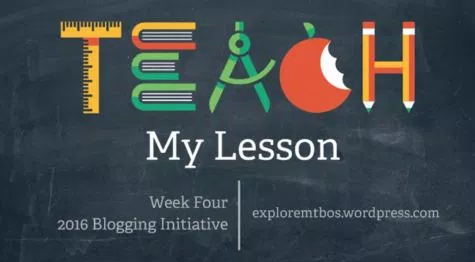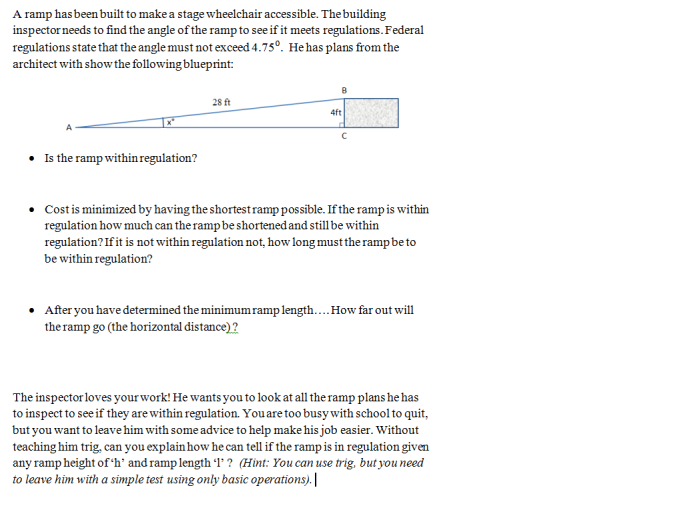
I have been busy planning out a unit on trigonometric ratios for my Geometry B course. I have been trying to balance the open ended exploration and project based learning that I prefer with the more typical questions that students will eventually see on state tests or future math classes.
Here is the standard I’m addressing with this lesson: G-MG.3 Apply geometric methods to solve design problems (with a focus on constraints).
I introduce trig with the slope ratio, proportions, and physically measuring before I ever tell them the word tangent. I’m leaning toward using Kate Nowak’s Introduction to Trig and then running a few Labs where calculate heights and distances of physical things outside before offering this:

My File Available Here: Constraint Problem
Afterwards I might show a few ramp fails before giving them a more open ended design problem. I’m still working on the actual formatting piece, but it will be a blueprint showing a door/stoop 5 ft high, but due to size of parking lot also has a restriction on length. Students will figure out it is not possible to use one ramp in that space and will have to figure out how to use two or more ramps to fit the constraints.
Nothing too mind blowing or exciting here, but I figure it gets at what I’m hoping they understand. Any suggestions are much appreciated.

This sounds like an interesting lesson. I notice how you write, “I want trig with the slope ratio, …, before I ever tell them the word tangent.” I suppose this means that the students answer the questions using a ruler and protractor to measure, rather than trig buttons on a calculator. I see what you’re doing here — just telling the students, “We are going to learn trigonometry now,” leaves the students wondering why they must learn it and being resistant. This approach, on the other hand, introduces a question first, and then they discover that trig is the way to solve it.
I look forward to finding out whether this lesson was successful or not — even more so because I’m especially interested in Geometry lessons.
Thanks for participating in the 2016 MTBoS.
LikeLike
Apparently I should proofread before I publish… It should have said “I introduce trig” with the slope ratio. Basically, I give them lines with an angle measured from the horizontal and have them draw different sized slope triangles. They see or remember that the slope ratio doesn’t change for that line, but any other non parallel line will have a different slope ratio. They find missing pieces given coordinate points or find delta y or a given delta x all for the same line.
Then I have them draw slope triangles for various other combinations and have them measure the angles and do the process again. Afterwards, I introduce the word tangent and we discuss why it might have a different name, as opposed to always referring to it as slope. This leads to triangles oriented in different directions and then eventually sine and cosine when the hypotenuse is know.
LikeLike
I agree David. Giving students a need for new math tools is enticing. The more we can have students play around with math concepts before we do our “directing teaching” is powerful.
LikeLike
Here’s a fun, kinesthetic activity to help students to remember Trig ratio: Tap Tap Trigonometry.
LikeLike
I like that you introduce trig functions without the names. I have used some hands-on labe from Henri Picciotto’s Geometry Labs (http://www.mathedpage.org/geometry-labs/)–specifically the first few lessons in Section 11. I never used the Geoboard (never had any to use), but my students still had success with the paper version (http://www.mathedpage.org/circle/circles/10cm-circle.pdf or page 243 in the book). Not quite as fun as a “ramp,” but also takes it slow and reinforces the ratios more than the names.
LikeLike
I like the extension problem with the ramp needing minimum materials. Gives the students a connected look at how the angle increases or decreases as the ratio changes. Nice.
LikeLike